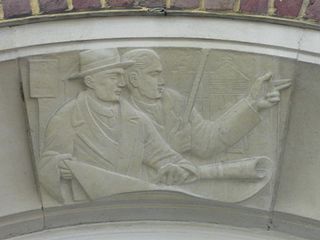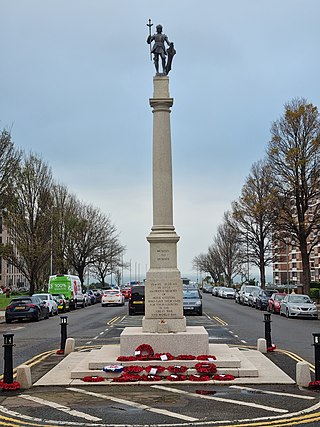History
Bateman's is a Jacobean Wealden mansion constructed in 1634. There is debate as to the original builder. Historic England follows the tradition favoured by Kipling of ascribing the construction to a Sussex ironmaster, John Britten. [3] The historian Adam Nicolson reports the tradition in the National Trust's guidebook, but notes that Britten was a dealer in iron, rather than a manufacturer. Pevsner attributes the construction to a lawyer, William Langham.
By the early twentieth century, the house had descended to the status of a farmhouse, and was in a poor state of repair. [1] The Kiplings first saw it in 1900, on returning to England from America, following the death of their daughter Josephine in 1899 and a disastrous falling-out between them and Carrie Kipling's brother, Beatty Balestier. Enchanted by the house, they were too slow in making an offer and it was let for two years. In 1902, they were able to purchase it, with 33 acres of land, from a wealthy stockbroker, Alexander Carron Scrimgeour. [7]
In 1900, Kipling was the most famous author in England, and was earning £5,000 per year; the cost of Bateman's, £9,300, was thus entirely affordable. Kipling wrote some of his finest works at the house including: "If—", "The Glory of the Garden", and Puck of Pook's Hill , named after the hill visible from the house. The house's setting and the wider local area features in many of his stories. Kipling's poem "The Land" is inspired by the Bateman's estate. [9]
Kipling's only son, John, was killed at the Battle of Loos on 29 September 1915. [10] Kipling died on 18 January 1936, of peritonitis. Carrie died three years later, in 1939. Under the terms of her will the house passed to the National Trust. [1]
Architecture and description
The house is built of sandstone to a double-pile plan, and is of two storeys with gables above. [3] The eastern entrance, front may once have been symmetrical with a northern wing matching the southern one. [3] Historic England's listing states that the wing was constructed but later torn down, [3] while Pevsner suggests that it may never have been built. The windows are mullioned and the roof has an "impressive row of six diamond-shaped red brick chimney stacks". [3]
The interior is retained as it was in the time of the Kiplings. [3] The study is almost as Kipling left it, although without the "pungent aroma" of his forty-a-day Turkish cigarette habit. The house contains a significant collection relating to Kipling, amounting to nearly 5,000 individual pieces, including his Nobel Prize, his Rolls-Royce Phantom I, many oriental items he purchased while living in India or touring in the East and paintings he collected by Edward Poynter, Edward Burne-Jones and James Whistler. [13]
The garden was created by Kipling from 1907, using the prize money from his award of the Nobel Prize in Literature. The house is a Grade I listed building, the highest grade reserved for buildings of "exceptional interest". [3]

Joseph Rudyard Kipling was an English novelist, short-story writer, poet, and journalist. He was born in British India, which inspired much of his work.

Burwash, archaically known as Burghersh, is a rural village and civil parish in the Rother district of East Sussex, England. Situated in the High Weald of Sussex some 15 miles (24 km) inland from the port of Hastings, it is located five miles (8 km) south-west of Hurst Green, on the A265 road, and on the River Dudwell, a tributary of the River Rother. In an area steeped in history, some nine miles (14 km) to the south-east lies Battle Abbey and eight miles (13 km) to the east is Bodiam Castle.

Brunswick Town is an area in Hove, in the city of Brighton and Hove, England. It is best known for the Regency architecture of the Brunswick estate.

There are 24 Grade I listed buildings in the city of Brighton and Hove, England. The city, on the English Channel coast approximately 52 miles (84 km) south of London, was formed as a unitary authority in 1997 by the merger of the neighbouring towns of Brighton and Hove. Queen Elizabeth II granted city status in 2000.

There are 72 Grade II* listed buildings in the city of Brighton and Hove, England. The city, on the English Channel coast approximately 52 miles (84 km) south of London, was formed as a unitary authority in 1997 by the merger of the neighbouring towns of Brighton and Hove. Queen Elizabeth II granted city status in 2000.

As of February 2001, there were 1,124 listed buildings with Grade II status in the English city of Brighton and Hove. The total at 2009 was similar. The city, on the English Channel coast approximately 52 miles (84 km) south of London, was formed as a unitary authority in 1997 by the merger of the neighbouring towns of Brighton and Hove. Queen Elizabeth II granted city status in 2000.

As of February 2001, there were 1,124 listed buildings with Grade II status in the English city of Brighton and Hove. The total at 2009 was similar. The city, on the English Channel coast approximately 52 miles (84 km) south of London, was formed as a unitary authority in 1997 by the merger of the neighbouring towns of Brighton and Hove. Queen Elizabeth II granted city status in 2000.

John Leopold DenmanFRIBA was an architect from the English seaside resort of Brighton, now part of the city of Brighton and Hove. He had a prolific career in the area during the 20th century, both on his own and as part of the Denman & Son firm in partnership with his son John Bluet Denman. Described as "the master of ... mid-century Neo-Georgian", Denman was responsible for a range of commercial, civic and religious buildings in Brighton, and pubs and hotels there and elsewhere on the south coast of England on behalf of Brighton's Kemp Town Brewery. He used other architectural styles as well, and was responsible for at least one mansion, several smaller houses, various buildings in cemeteries and crematoria, and alterations to many churches. His work on church restorations has been praised, and he has been called "the leading church architect of his time in Sussex"; he also wrote a book on the ecclesiastical architecture of the county.
Thomas Simpson (1825–1908) was a British architect associated with the seaside town of Brighton. As architect to the Brighton and Preston School Board and the equivalent institution in neighbouring Hove, he designed "a distinguished group of board schools" during the late 19th century, when the provision of mass education was greatly extended. Many of these schools survive and some have listed status. He also worked on five Nonconformist chapels for various Christian denominations, using a wide variety of materials and architectural styles. He was the father of Sir John William Simpson and Gilbert Murray Simpson, who both became architects.
The Kipling Society is a literary society open to everyone interested in the work and life of British author Rudyard Kipling (1865–1936). The Kipling Society focuses on Kipling and his place in English Literature, and as such attracts members from all over the world, both general readers and academic researchers.

Hove War Memorial is a First World War memorial designed by Sir Edwin Lutyens and located on Grand Avenue in Hove, part of the city of Brighton and Hove, on the south coast of England. Hove was the site of one of the earliest recruiting events at the beginning of the war and later of several military hospitals. Over 600 men from the town were killed during the war, a quarter of them from the local regiment alone. A war memorial committee was established in 1919 and Lutyens was engaged as architect. A design was agreed in 1920 after two unsuccessful proposals; Lutyens chose the site from several options.
Robert Thurston Hopkins (1884–1958) was a British writer and ghost hunter.

Norman Adolphus Evill FRIBA was an English architect and draughtsman, apprenticed to Edwin Lutyens.

Caroline Starr Balestier Kipling was the American-born wife of Rudyard Kipling and the custodian of his literary legacy after his death in 1936.

St Bartholomew's Church is a parish church in the village of Burwash, East Sussex, England. It is a Grade II* listed building.

Seacox Heath is a house in the village of Ticehurst in East Sussex, England. It is owned by the Russian government and is used a weekend retreat by the staff of their embassy in London.
This page is based on this
Wikipedia article Text is available under the
CC BY-SA 4.0 license; additional terms may apply.
Images, videos and audio are available under their respective licenses.















